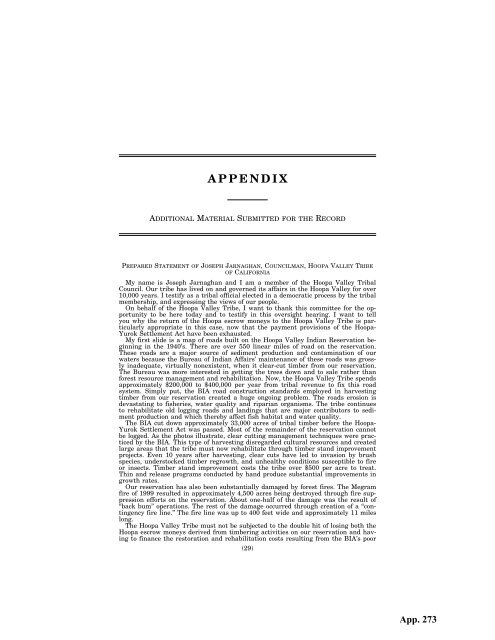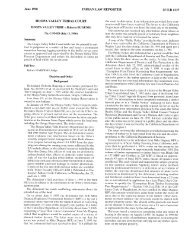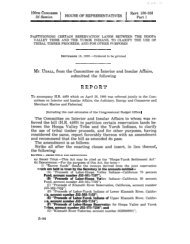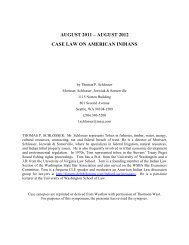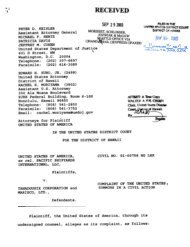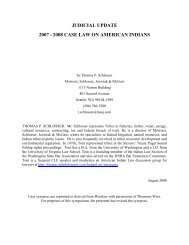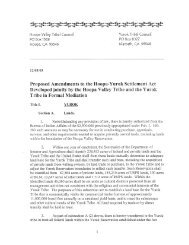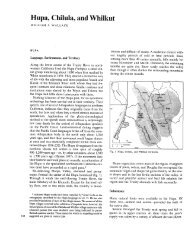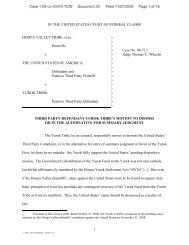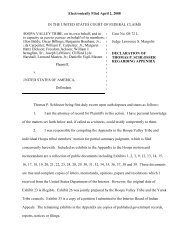Hoopa appendix supporting summary judgment - Schlosser Law Files
Hoopa appendix supporting summary judgment - Schlosser Law Files
Hoopa appendix supporting summary judgment - Schlosser Law Files
Create successful ePaper yourself
Turn your PDF publications into a flip-book with our unique Google optimized e-Paper software.
APPENDIX<br />
ADDITIONAL MATERIAL SUBMITTED FOR THE RECORD<br />
PREPARED STATEMENT OF JOSEPH JARNAGHAN, COUNCILMAN, HOOPA VALLEY TRIBE<br />
OF CALIFORNIA<br />
My name is Joseph Jarnaghan and I am a member of the <strong>Hoopa</strong> Valley Tribal<br />
Council. Our tribe has lived on and governed its affairs in the <strong>Hoopa</strong> Valley for over<br />
10,000 years. I testify as a tribal official elected in a democratic process by the tribal<br />
membership, and expressing the views of our people.<br />
On behalf of the <strong>Hoopa</strong> Valley Tribe, I want to thank this committee for the opportunity<br />
to be here today and to testify in this oversight hearing. I want to tell<br />
you why the return of the <strong>Hoopa</strong> escrow moneys to the <strong>Hoopa</strong> Valley Tribe is particularly<br />
appropriate in this case, now that the payment provisions of the <strong>Hoopa</strong>-<br />
Yurok Settlement Act have been exhausted.<br />
My first slide is a map of roads built on the <strong>Hoopa</strong> Valley Indian Reservation beginning<br />
in the 1940’s. There are over 550 linear miles of road on the reservation.<br />
These roads are a major source of sediment production and contamination of our<br />
waters because the Bureau of Indian Affairs’ maintenance of these roads was grossly<br />
inadequate, virtually nonexistent, when it clear-cut timber from our reservation.<br />
The Bureau was more interested in getting the trees down and to sale rather than<br />
forest resource management and rehabilitation. Now, the <strong>Hoopa</strong> Valley Tribe spends<br />
approximately $200,000 to $400,000 per year from tribal revenue to fix this road<br />
system. Simply put, the BIA road construction standards employed in harvesting<br />
timber from our reservation created a huge ongoing problem. The roads erosion is<br />
devastating to fisheries, water quality and riparian organisms. The tribe continues<br />
to rehabilitate old logging roads and landings that are major contributors to sediment<br />
production and which thereby affect fish habitat and water quality.<br />
The BIA cut down approximately 33,000 acres of tribal timber before the <strong>Hoopa</strong>-<br />
Yurok Settlement Act was passed. Most of the remainder of the reservation cannot<br />
be logged. As the photos illustrate, clear cutting management techniques were practiced<br />
by the BIA. This type of harvesting disregarded cultural resources and created<br />
large areas that the tribe must now rehabilitate through timber stand improvement<br />
projects. Even 10 years after harvesting, clear cuts have led to invasion by brush<br />
species, understocked timber regrowth, and unhealthy conditions susceptible to fire<br />
or insects. Timber stand improvement costs the tribe over $500 per acre to treat.<br />
Thin and release programs conducted by hand produce substantial improvements in<br />
growth rates.<br />
Our reservation has also been substantially damaged by forest fires. The Megram<br />
fire of 1999 resulted in approximately 4,500 acres being destroyed through fire suppression<br />
efforts on the reservation. About one-half of the damage was the result of<br />
‘‘back bum’’ operations. The rest of the damage occurred through creation of a ‘‘contingency<br />
fire line.’’ The fire line was up to 400 feet wide and approximately 11 miles<br />
long.<br />
The <strong>Hoopa</strong> Valley Tribe must not be subjected to the double hit of losing both the<br />
<strong>Hoopa</strong> escrow moneys derived from timbering activities on our reservation and having<br />
to finance the restoration and rehabilitation costs resulting from the BIA’s poor<br />
(29)


